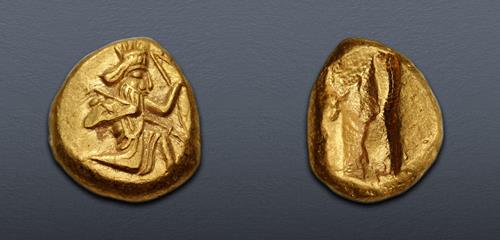|
PERSIA, Achaemenid Empire. temp. Xerxes I to Darios II. Circa 485-420 BC. AV Daric (13.5mm, 8.26 g). Lydo-Milesian standard. Sardes mint. Persian king or hero, wearing kidaris and kandys, quiver over shoulder, in kneeling-running stance right, holding spear and bow / Incuse punch. Carradice Type IIIb, Group A/B (pl. XIII, 27); Meadows, Administration 321; BMC Arabia pl. XXIV, 26; Sunrise 24. Trace deposits. EF.
The Achaemenid series began in the late sixth century BC, deriving from the famous Kroiseid coinage, and lasted until the conquest of Persia by Alexander the Great in the 330s BC. The term “daric” dates from the fifth century BC, and was used by the Greeks as a term for Persian coinage, particularly the gold (see Herodotos 7.28). Its name derives from that of the Persian king Darios I, under whom the Persian coinage began. Ian Carradice’s study, “The ‘Regal’ Coinage of the Persian Empire” in: Coinage and Administration in the Athenian and Persian Empires (BAR International Series 343 [Oxford. 1987]) forms the modern basis for our understanding of this interesting coinage.
The final winners of all CNG Feature Auction 129 lots will be determined during the live online sale that will be held on 13-14 May 2025. This lot is in Session One, which will begin 13 May at 9 AM ET.
Winning bids are subject to a 22.5% buyer's fee for bids placed on this website and 25% for all others.
We recognize that our users may have various Internet Browsers and Operating Systems. We like our visitors to have the best possible experience when using our bidding platform. However, we do recognize that it is impossible to develop applications that work identically, efficiently and effectively on all web browsers. The CNG bidding platform supports the latest stable major version and stable previous version of Chrome and Firefox.
|
